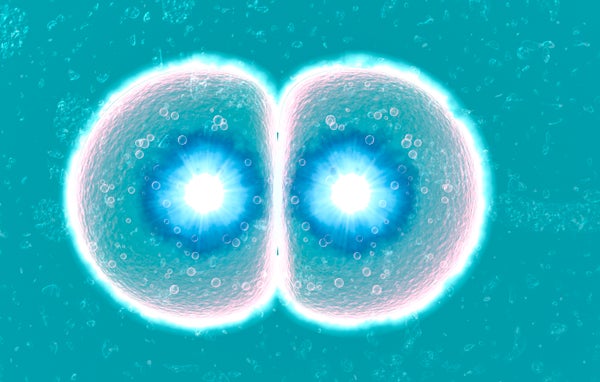Baby-making science has crossed a new threshold, at least in rodents. A team of scientists in China has managed to create a small number of apparently healthy mouse pups from same-sex female parents. The researchers also generated offspring from two mouse dads—but those pups all died shortly after birth, underscoring the fact that the new technique still faces serious hurdles.
The team’s approach, which relies on stem cell science and CRISPR–Cas9 gene editing, is a “new way to produce offspring of same-sex mammals,” says senior author Qi Zhou, who works on stem cell and reproductive biology at the Chinese Academy of Sciences.
If the process can be vastly improved, and if it works well in larger mammals, it may eventually offer hope to human same-sex couples who want to have kids that are biologically related to both parents. Yet that scenario remains distant, and may never become scientifically feasible at all. “The amount of work that is necessary to convince us that doing this in humans will do no harm is enormous, and is very much ahead of us,” says Fyodor Urnov, deputy director of Altius Institute for Biomedical Sciences in Seattle, who was not involved in the research. Moreover, it would remain extremely controversial—in part because offspring from two females would not have Y chromosomes, and thus could only be female.
On supporting science journalism
If you're enjoying this article, consider supporting our award-winning journalism by subscribing. By purchasing a subscription you are helping to ensure the future of impactful stories about the discoveries and ideas shaping our world today.
Other researchers had previously derived offspring from two female mice, but the rodents developed various health problems and the process was more cumbersome, Zhou says. Scientists in the U.S. had also earlier produced offspring from two male mice, but that work employed an entirely different technique that involved creating an intermediate “mother”—meaning one of the fathers was given the ability to form eggs. That bi-paternal process would not be applicable to humans (at least with current technologies) because it builds on a genetic anomaly that would render a human infertile, says Richard Behringer, a genetics professor at The University of Texas M. D. Anderson Cancer Center who led the earlier two-fathers work. The research conducted by Zhou and colleagues, he says, is “a technical tour de force.” The team’s findings were reported Thursday in a study published in Cell Stem Cell.
To obtain mice biologically related to two moms, Zhou and his colleagues exposed immature eggs to chemicals that made the eggs act like they were fertilized, and start dividing. From those eggs, the scientists were then able to harvest stem cells that were haploid—meaning each contained only half the typical number of chromosomes, instead of a complete set from two parents.
The researchers then “washed out” the haploid stem cells’ remaining instructions to act like eggs. They accomplished this by using CRISPR to delete three essential regions of DNA, which control what switches are turned on and off along the genome to express a specific parent’s genes (a phenomenon called imprinting). After that they needed to coax those same cells to act more like sperm, so they deleted still other key DNA sequences that were controlling which genes were turned on or off. Next the researchers injected each artificial sperm cell into another egg, creating a bi-maternal embryo. Finally the embryo was implanted into the womb of a third mouse that acted as a surrogate mother. In this way the team ended up with 29 live mice from 210 embryos—a success rate of roughly 14 percent. Those pups grew up and went on to have offspring of their own, fathered by male mice.
Trying to produce mice with two dads was even more complicated, and far less successful. The early steps were similar: starting with sex cells (this time sperm) and harnessing laboratory techniques to elicit haploid stem cells. Then the researchers deleted seven DNA regions, areas that control imprinting, from each of those cells. Next they injected each of those modified sperm stem cells—along with a second father’s sperm—into an enucleated egg (one that had its nucleus removed so it had no biological instructions of its own). To make this two-dad system work they still needed a placenta, which nourishes a fetus during pregnancy. So they next had to conduct an arduous process to obtain placenta-forming material from a completely separate, nonviable embryo, and then incorporated that outside contribution into the bi-paternal embryo. Eventually that cobbled-together embryo was implanted into a surrogate mother. Less than 2 percent of the mice created in this way were born alive, and any that were died shortly after birth.
“The quick death of the offspring revealed that there were still some unknown reproduction/development barriers to cross in the production of bi-paternal mice,” notes the Academy’s Baoyang Hu, a senior author of the new study. “In nature, bi-maternal reproduction—or parthenogenesis—is quite common among vertebrates such as in amphibians, reptiles and fish. However, successful reproduction from two males is very rare, and can only be found in specific fish under experimental conditions.” That means the production of bi-paternal mice “might need to cross more barriers than the bi-maternal mice.”
Yi Zhang, a professor of genetics at Harvard Medical School who was not involved with the work, says the main benefit of these new findings lies in addressing some basic science questions, and in the way it is testing the scientific bounds of reproduction and epigenetics. “From a scientific point of view, even for mice this is very difficult,” he says. “And for primates and humans, it’s going to be 10 times more difficult.”
